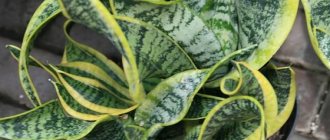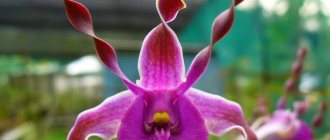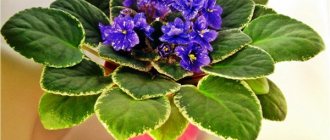Each of us, even being very far from indoor floriculture, can easily recognize and name this flower. Of course, the difficult-to-pronounce scientific name of Sansevier will not only be pronounced, but only remembered by a specialist botanist or a keen florist. It’s either a matter of “mother-in-law’s tongue” or “pike tail”! Everyone will remember these names!
This ornamental plant grows in kindergartens, schools, offices and workshops and does not require special attention and care. From what places did the pike tail move to us? Where is the birthplace of the plant - so unpretentious and decorative -? We will try to answer all questions.
How many names does he have?
Let's start, perhaps, with the official language of almost all terms - Latin. Sansevieria (sansevieria) - this is exactly what the name of this representative of the decorative fauna actually sounds like. The flower was named in honor of the philanthropist and botany lover, the Italian aristocrat Raimondo de Sangro, Prince von Sansevierio, who lived in the 18th century.
Pike tail is the name given to this plant by people who saw a pattern in the stripes on the leaves of one of the species that was similar to the color of a river predator. Another bright epithet that has taken root among us is mother-in-law’s tongue. Most likely, a parallel should be drawn here with the long tongue of the heroine of such popular jokes among us. It is difficult to find any other reason for the appearance of such a name, other than the ineradicable sense of humor of the Russian people.
However, in the search for interesting names that at least somewhat accurately characterize sansevieria, our people are not at all original. The Germans call this plant African hemp, the British - the tongue of the devil, or leopard lily, the Americans - snake skin, which indicates the popularity of the species in different countries.
Applications of Sansevieria
In its homeland, sansevieria is successfully used as a hedge. Its leaves contain valuable technical fiber, from which local residents used to make bow strings. Currently, in tropical countries, certain types of sansevieria are cultivated to produce this fiber. Sansevieria is also a medicinal plant. It is used to treat cystitis and inflammation of the appendages. With the help of this plant, you can increase resistance to viral and colds and enhance adaptive abilities.
Sansevieria has been grown in Europe as an ornamental plant since the 18th century, considered an unpretentious and hardy indoor plant that is suitable even for the novice gardener. In summer, Sansevieria graces man-made landscapes, as its showy leaves create the perfect backdrop for plants with small flowers or feathery leaves. This plant is used for landscaping winter gardens and creating compositional arrangements.
Where is his homeland?
The tropics and subtropics are where the pike tail feels great and develops well. The homeland of the sansevier plant is the tropical regions of Africa, mostly its western regions. Modern researchers quite often discover new species of sansevieria in Uganda, Kenya and neighboring countries.
Today this plant is widespread in Sri Lanka and India, tropical Asia and the island of Madagascar, South Florida. As a rule, in nature, sansevieria grows in clumps, forming impenetrable thickets on river banks. It can coexist with both huge spreading baobabs and low acacias of various types and succulents. This flower can grow in any poor soil with low humidity - about 40%. That is why the pike tail tolerates conditions in which other indoor flowers cannot exist without problems.
Growing Sansevieria
Thanks to its external characteristics, Sansevieria is organically combined in the decor of premises , decorates the artificial landscape, and adds variety to the winter garden.
In order for a luxurious, highly ornamental plant to grow, you need to water it properly, monitor air humidity and feed it occasionally. Excess moisture harms the plant. Especially in winter, the roots can rot and lead to the death of a beautiful representative of the flora. After each procedure, you need to wait until the soil dries completely, and then moisten it again. In cool weather, watering is rare. The leaves benefit from wetting with a damp cloth.
There should be enough light for a healthy appearance. When there is insufficient light, the leaves fade, and when there is too much light, they turn yellow. It tolerates short-term placement in the shade without any problems. The best part of the territory for fruitful growth is western or eastern. In summer, the pot can be placed on the balcony or in the garden, closer to wildlife.
For a plant to grow well, it needs to be fed. Regular fertilizer for indoor flowers, namely cacti, works well in this case. The frequency of feeding is once a year. This is no longer necessary, as the individual colors of the leaves are lost: they will simply be green.
Beautiful and useful
Following the Asian and African healers who widely used pike tail in their practice, the beneficial properties of this plant were also noticed in our country. Saponins (glycosides of plant origin) contained in its leaves have anti-inflammatory and mucolytic, adaptive and immunostimulating effects. In addition, scientists have found that sansevieria significantly reduce the number of pathogenic microorganisms in the air of the room where they are located, and are also able to reduce the content of harmful synthetic substances such as trichlorethylene and benzene.
Sansevieria origin story
Sansevieria - originates from subtropics and savannas. It takes its ancestral roots from the poor and rocky soils of Sri Lanka, Central Africa, Asia, India and Madagascar. It is there that this plant reaches the peak of its perfection.
Sansevieria has been known since the 18th century; it received its name in honor of the Neapolitan prince, who made a great contribution to the development of the science of botany. Sansevieria is classified as an evergreen asparagus crop.
In addition to the main name, Sansevieria has several other popular names, such as pike tail, mother-in-law's tongue and even snake skin. However, no matter what they call it, the fact remains that it is a hardy and unpretentious crop, and is a great succulent. It has common properties with the Agave plant from which Mexican Tequila is produced.
For its power and beauty of its leaves, for the strength of the root system, for its high resistance to disease, sansevieria has earned the attention of travelers and botanists. Thanks to which it spread throughout the globe.
As a home culture in pots, it can be found on every continent on the planet. As an outdoor plant, sansevier is able to survive only in conditions similar to its historical homeland (it prefers more southern regions with rocky soil from where it came to us).
There is no better natural filter for the ambient air than Sansevieria. Serving people, it saturates their home with oxygen and absorbs harmful elements. A person who has one, or better yet several, Sansevieria plants in his apartment can rest assured about his lungs.
Botanical characteristics
Sansevieria, or Sansevieria, is a genus of evergreen herbaceous stemless perennial plants. According to different scientific schools, it belongs to various botanical families: asphodelaceae, agave or dracaenaceae. Such a difference of opinion is not fundamental, since this is all the lily family, but only “broken” into smaller groups. Today, the genus Sansevieria usually includes about 60-70 different species and many different varieties.
Like many other houseplants, piketail, which is native to arid tropical areas, has a well-developed underground creeping rhizome. The hard leaves form a rosette and can reach 1 meter in length (or more) in some species. As a rule, the leaf plates are pointed and can be either vertical or almost horizontal. Leaf color varies from light green to brown, with various stripes and spots. Silver- and gold-colored houseplants have become fashionable over the past few decades. The pike tail, whose homeland is in tropical countries, did not escape a similar fate: through the efforts of breeders, varieties of this plant with leaf coloring unusual for it were bred. Sansevieria flowers are pale green, collected in cylindrical inflorescences on a long and straight peduncle. In nature, a fruit-berry is formed, with 1-3 seeds, but in indoor floriculture, fruiting is extremely rare.
Sansevieria flower: home care
Any indoor Sansevieria plant requires compliance with the following rules of care:
- Lighting. If succulents don't get enough light, they won't develop well. To obtain beautiful leaves, bright and rich, you should provide the bushes with a lot of sunlight. In summer, it is recommended to provide the bushes with light shading. Variegated varieties with excess sunlight will have yellow leaves. Therefore, it is better to protect them from direct ultraviolet rays.
- Temperature indicators. The culture is not picky about temperature indicators; it needs values of +16...20 degrees at night, +21...28 degrees during the day. When exposed to cool conditions for an extended period, succulents will need to reduce watering.
- Watering rules. Any indoor Sansevier flower is drought-resistant, since its homeland is African countries. Irrigation is carried out lightly; a certain interval must pass between soil moisture. Be sure to ensure that water does not get inside the outlet, as this can cause rot. There is no point in spraying the bush, but you will need to systematically clean the leaves, removing dust with a cloth or broom.
- Fertilizers. Starting from May and ending in September, the crop should be fertilized once every 14 days. The rest of the time you will need to fertilize only once every 30 days. If the wintering is too cold, the Sansevieria genus does not need additional nutrients at all. To fertilize crops, use minerals. Variegated varieties do not tolerate compounds containing nitrogen.
Separately, we should talk about replanting crops.
It is carried out as the succulent matures. Young bushes are replanted every year, and adults - once every 2-3 years, after the container becomes too crowded. The new container is not deep, 2 centimeters wider than the old one. Remember that crops do not like a lot of soil; they have a superficial, shallow root system. The soil chosen is light, it should dry quickly and be low in nutrition. The optimal solution is to use special mixtures of soil for succulents or cacti. You can also create soil from turf, leaf soil, or sand. All components are taken in equal proportions. When making your own soil, do not forget to calcine it using the oven.
Variety of types and shapes
Today, in indoor floriculture, many types and forms of a flower with such an interesting name are cultivated - pike tail. The plant’s homeland, as has already been mentioned several times, is tropical and subtropical regions, but only a few species grow there, from which many modern forms were obtained.
Despite the fact that there are about 70 species of Sansevieria in nature, only about 10 are cultivated in indoor and decorative floriculture, of which the following are the most beloved:
- Sansevieria trifasciata is the most popular variety with three colors. The most common varieties among gardeners are Laurenti (with a golden border along the edge of the sword-shaped leaf), Prain (without such a border) and Craigil - with a wide cream stripe along the outer edge.
- Sansevieria grandis is a large leaf with alternating stripes of darker and lighter shades of green, edged with a thin reddish stripe.
- Sansevieria hiberica - wintering, with hard leaves decorated with reddish stripes.
- Low-growing varieties of sansevieria, such as Sansevieria hahnii silver and Hahnii golden.
Sansevieria in the interior of the house
Sansevieria is often used to decorate a home or office. Plants planted in a group in low and round pots look great. By placing several containers in a symmetrical order, you can create an unreal composition on the windowsill.
Varieties of plants with thick leaves that grow in a spiral allow the formation of original “flat” plant shapes. The leaves are fixed with a stick in the desired position and left for a long period. From time to time such cultures turn around.
Root layering
This is the easiest way to get yourself such an unpretentious flower as pike tail. The plant’s homeland is quite harsh in terms of climatic conditions, so Sansevieria, trying to occupy new habitats, forms a rather dense root shoot. This behavior is typical not only of flowers growing in the wild, but also of domesticated flowers. Usually quite a lot of shoots with roots form in the pot.
Dig up a few (along with the roots and a ball of earth) and cut them from the mother plant, then replant them in a new pot. The place from which you cut a piece needs to be dried a little and sprinkled with crushed charcoal, or regular activated charcoal.
Transplanting a plant
The rhizome of young shoots develops rapidly, so the capacity must be constantly increased. It should be low and wide, with drainage holes. A strong root system can rupture a fragile vessel. In this sense, it is preferable to plant Sansevieria in ceramic dishes that will not tip over under the pressure of a large specimen. The soil for replanting is made up of chernozem, humus, sand and peat. Adding fine gravel will have a positive effect on the well-being of the plant.
Leaf cuttings
The method is simple: take a leaf of a flower, mark it and cut it crosswise into 7-10 cm pieces. Immediately use an adhesive plaster or permanent marker to mark the bottom of each fragment. This is quite important, since they will need to be planted with their heads up. In order for the cut pieces of leaf to dry, leave them on a cool windowsill for 1-2 days. Then we plant the resulting cuttings in well-moistened sand and, covering them with a glass jar, put them in a warm, bright place. There is no need to spray the cuttings, just pour water into the tray.
Plants will take root, under favorable circumstances, in 1-1.5 months. After which the seedlings can be transplanted into a pot with garden soil or a special soil mixture for succulents.
How to propagate plants of the genus Sansevieria
The most popular vegetative propagation of Sansevieria. The process is carried out through cuttings, dividing the rhizome, and using side shoots.
Young shoots of Sansevieria
Division is performed during the process of transplanting the crop. It is recommended to divide the plant and separate the side shoots so that the new crop has a point for growth. For such purposes, it is appropriate to use a knife, and treat the cut areas with activated carbon. Watering is carried out extremely moderately.
Sansevieria propagation by leaf cuttings is carried out according to the following scheme:
- The leaf is cut into 5 cm pieces perpendicular to the veins. For such purposes, it is important to use leaves from a rosette that previously bloomed and will no longer produce new leaves.
- The cut parts must be dried for several minutes. It is recommended to plant the crop in sand (preferably wet), observing the bottom and top of the cutting. Otherwise, root formation is impossible.
- The cuttings are covered with film, and a miniature greenhouse is formed. Watering is carried out through a tray.
- Rooting will take 6 to 8 weeks. When the first leaves appear, the crops are planted in separate pots.
Remember that such reproduction is only relevant for monochromatic representatives of the genus.
Appearance
Scientists disagree on which botanical family the plant belongs to. However, this does not matter much - the asphodel, agave or dracaena genus originates in the flower. By appearance, Sansevieria can be identified by its characteristic features:
- condition of the root system;
- leaf shape;
- leaf painting;
- type of inflorescences.
The creeping root owes its powerful strength to the fact that the homeland of the Sansevier plant is hot regions. In dry, rocky soil, the rhizome grows deeper and wider in search of moisture.
Dense, fleshy leaves emerge from a rigid basal rosette. There are species whose leaves are covered with a waxy coating, which prevents the evaporation of moisture. They reach a length of up to a meter or more, ending with a point. The peculiarity of sheet plates is their orientation:
- erect;
- horizontally extended along the ground;
- chaotic, versatile layout.
The unique color palette of the leaves was given to the plant by the homeland of the Sansevieria flower. There are up to 70 types of sultry beauties with spotted, striped, green, yellow, silver, and brown shades.
A representative of the evergreen family pleases with its rare flowering at home. , white flowers with a green tint grow close to each other . Beneath them, drops of nectar exude a fragrant aroma. They are shaped like a lily. Sansevieria blooms in the evening. Pollinating insects flock to the vanilla aroma. In nature, at home, Sansevieria forms a fruit with several seeds.
Why does Mother-in-law's tongue droop?
Sansevieria is a guest from hot African regions, so it loves light, warmth, dry soil and air. So, if in Sansevieria: The leaves become damp, turn yellow and rot at the base - there is too much water. The leaves droop and become limp - the sansevieria is too cold.
Interesting materials:
What to do if your iPhone screen is dull? What to do if the screen on your iPhone is larger? What to do if iTunes doesn’t recognize the iPhone? What to do if the computer does not see the iPhone via USB? What should I do if I can’t hear you well on my iPhone? What to do if you have an iPhone 4? What to do if the apple blinks on iPhone 5? What to do if the accessory is not supported on your iPhone? What to do if there is a black screen and loading icon on your iPhone? What to do if the apple on your iPhone is on fire?
Properties of Sansevieria and signs
It is known from primary sources that the pike tail is capable of purifying the air in the room where it is located. It is especially useful to keep it in houses with plastic windows and doors.
NASA researchers have proven that the plant is capable of absorbing carbon dioxide, formaldehyde and other toxic substances. However, this occurs during the day during photosynthesis, releasing pure oxygen. At night, the reverse process occurs - carbon dioxide is released into the atmosphere.
Apparently for this reason, many myths and legends have developed around the plant, taken from past generations. It was believed that Sansevieria is capable of absorbing aggression and helps create harmony and positive energy. A person regains consciousness, nerves calm down after conflicts, and focuses on the task.
It has also been scientifically proven that plant leaves contain biologically valuable substances - salonins. They are part of medications that have choleretic, anti-inflammatory, and laxative effects. They are excellent foaming agents included in shampoos and washing gels.
In conclusion, we note that Sansevieria is a favorite plant among many gardeners for the unusual color of its leaves with bright stripes. Fits perfectly into any interior. It has antibacterial properties, cleaning the space around it. Flowering symbolizes a favorable time for any endeavors and the fulfillment of cherished desires.











